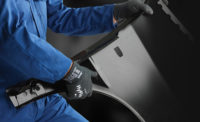This scenario is too common as safety personnel and workers overestimate their hand protection’s performance capabilities, or underestimate the degree of risk. Sometimes workers and safety personnel are unaware of the extent of the hazards involved.
Problems associated with overestimating gloves’ protective abilities include increased injuries and medical indemnity costs, reduced productivity, lower worker morale and higher worker turnover. Over time, managers will likely notice an increase in glove consumption as workers double glove in an effort to keep their hands safe. Workers are also more likely to discard hand protection products prematurely as they perceive injuries and near misses as a result of worn gloves.
Changing work environment
The question becomes why do companies overestimate the capabilities of their hand protection products — and what can they do to reduce injuries and the costs associated with this problem?
First, managers must recognize that changes in processes and technologies are inherent to every manufacturing facility. Second, they must consider specific factors that contribute to product overestimation. Adjustments, based on product performance, should reflect changes in workplace hazards as processes change in the factory.
Downsizing: Many companies are financially strapped these days and seeking ways to reduce costs, which often leads to a decrease in the number of workers. The increased workload may also create stress among workers, thus adding to the potential for injury.
If layoffs include safety managers, those remaining typically have more demands placed on them and find it impossible to be everywhere at once. Safety managers who once walked the plant floor and observed workers on the job are charged with larger areas and more employees. They often spend more time in their offices buried in paperwork and may be unaware a problem exists until they receive the injury report.
In some instances, human resource personnel are tasked with the role of safety director without the benefit of spending time on the plant floor and learning about the various processes. These individuals often rely on hand protection products selected by their predecessors without gaining feedback from workers as to whether the products provide sufficient protection.
Product migration: Downsizing the workforce may result in workers assigned to new or different tasks. As workers move from one job to another, they often take their hand protection with them, even though the product may not provide the protection required. Unless workers are trained and understand when and where the gloves should be used, they may unknowingly place themselves at risk for injury.
Different processes and equipment: Plants that downsize or shut their doors often ship production and assembly equipment to other departments or locations. Workers at the new location may operate the equipment with the same hand protection they used for other jobs, which may fall short in its ability to keep them safe.
Eliminating product overestimation
Any company is vulnerable to overestimating the protective capabilities of its PPE. Below are steps to help eliminate this situation.
Benchmarking: Establishing benchmarks for all hand protection and other PPE will set a point of reference to measure future performance. Benchmarking should be part of a comprehensive assessment that reviews every application and invites workers to provide input about the benefits and challenges associated with their PPE. In some instances, workers may be more likely to confide issues and challenges to a stranger than to a coworker or manager.
Assessing applications and benchmarking will also help determine whether workers are employing best practices and using the latest technology. Worker observation and interviews at a food processing facility, for example, revealed individuals were wearing gloves made with Kevlar® for general purpose applications such as driving forklifts, taking product samples and light cleanup.
Workers were using leather driver’s gloves for jobs that involved cut hazards, such as changing blades on packing line equipment and working with utility knives in warehousing applications. These practices resulted in many near misses and some injuries, with a number of workers indicating they lacked confidence in their ability to safely perform their jobs.
To correct the situation and establish best practices, the company partnered with a glove manufacturer to conduct an assessment and establish PPE benchmarks at its primary site and other locations to confirm every plant facility was compliant.
Implementing PPE recommendations: Companies that commit to a PPE assessment and benchmarking must be willing to make the changes necessary to improve worker safety. Recommendations will be based on observation, worker input and evaluation of the risk.
Management at the food processing company mentioned earlier was surprised to learn of the PPE application and immediately implemented the recommendations made by the glove manufacturer that conducted the assessment.
Recommendations included providing hand protection with Level 2 cut protection for applications such as preventative maintenance. Level 4 products were suggested for applications involving knives and blades, and a general purpose glove with greater dexterity was recommended for fork lift drivers, workers performing janitorial tasks and individuals removing bent plastic containers from filler machines.
Training and follow-up: Providing the appropriate hand protection for the application is not enough. Companies must educate workers about how and when to use the PPE and why changes were implemented. Any number of communication channels may be employed for training — glove boards, company intranet, newsletter, departmental meetings.
The food processor detailed above used glove boards and employee meetings to educate workers about the new products being implemented. Workers were receptive and willing to wear new hand protection products once they understood the advantages.
The facility also conducted a follow-up assessment to confirm individuals were still using the right gloves for the applications — even though the plant had already experienced a decline in near misses and injuries.
Reap the rewards
By setting benchmarks during the assessment, implementing recommended changes and providing workers the appropriate training, companies can significantly reduce near misses and injuries. They will likely reap other benefits, too, including greater worker confidence and productivity, reduced costs and lower employee turnover.






